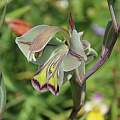Most Gladiolus sport a few lines and spots on their flowers, but there are some so heavily patterned that the base color becomes obscured.
Gladiolus orchidiflorus Andrews is found on clay and sandstone soils from Namibia to Cape Flats and also to Free State and flowers in the spring. It has linear to sword-shaped leaves that are thickened in the midline. Flowers are in a 5 to 12 flowered spike, windowed in profile, greenish to purple with dark purple markings on the lower tepals, and are very fragrant. Photos 1-2 are habitat shots taken in Namaqualand by Bob Rutemoeller and Mary Sue Ittner September 2006. Photos 3-4 were taken near Carolusberg, Namaqualand by Cameron McMaster September 2011.
The photos below were taken by Alan Horstmann.
Gladiolus recurvus Linnaeus occurs in shale derived soils from Ceres to Bredasdorp and flowers from June to October depending on the elevation. The fragrant flowers are pale gray to cream, yellowish or pinkish with purple lines and dots on the lower tepals and sometimes spotted or lined in the midline on the upper tepals as well. The first two photos were taken by Cameron McMaster in the Overberg. The other photos by Dirk Wallace show variation in the markings on flowers.
Gladiolus rufomarginatus G.J.Lewis is a summer-growing species with a narrow distribution in the Lydenburg area of Mpumalanga where it grows in grassland in open or shade on stony shale ground and sometimes in crevices in bare shale outcrops. It has long and slender leaf blades with margins and midrib strongly thickened and raised. Flowers are cream to pale straw and densely speckled with small, dark red spots. Bracts are pale and dry at anthesis and slightly transparent flushed with pink and with rusty brown margins. Photo taken by Rachel Saunders. In habitat it flowers March to April, sometimes in May.
Gladiolus sericeovillosus (Hook) is a medium sized summer flowering Gladiolus related to Gladiolus oppositiflorus with pale cream spotted flowers on a distichous spike from Transvaal grasslands. It comes in two subspecies. Photo from Rod Saunders.
G. sericeovillosus subsp. calvatus (Baker) Goldblatt is characterized by leaves which exceed the flower spike. This species may be found in trade as Gladiolus elliotii, likely because it was described by Lewis under this name, while the accepted Gladiolus elliotii (Baker) is a different species. Pictures by Martin Bohnet show a plant with exactly this misnamed history. He grows it in a container in southern Germany, even though some sources attest it hardiness to USDA Zone 7. The yellow throat markings are optional according to some descriptions.
G. sericeovillosus subsp. sericeovillosus has shorter leaves and fine hair on the bracts and stem. In some specimen, the spots on the flowers may be missing.
Gladiolus uysiae L.Bolus ex G.J.Lewis is brownish purple with dark veining and fragrant. It flowers late winter to early spring and can be found on clay slopes in renosterveld. Photos 1-4 were taken in habitat near Middelpos in the Roggeveld by Mary Sue Ittner, Bob Rutemoeller and Cameron McMaster.
The first three photos were taken by Alan Horstmann in 2023 near Middelpos. The fourth photo was taken by Cameron McMaster near Nieuwoudtville September 2011. The last photo taken by Bob Rutemoeller shows one grown by Gordon Summerfield in South Africa flowering September 2003
Gladiolus vinosomaculatus grows in exposed and often dry sites (rocky hilltops and slopes in short grassland) and on rocky outcrops in the summer rainfall areas of southern Africa north of the Vaal River. The tepals are covered with large purple to reddish spots on a pale background. The leaves have long sheaths that form a short pseudostem. This species is closely related to Gladiolus ecklonii. Photo taken by Rod Saunders.
Gladiolus watermeyeri grows on rocky sandstone slopes in the Northwest Cape. It is very fragrant and we could smell the one growing near Nieuwoudtville in the first photo from Mary Sue Ittner before we saw it. Photo 2 was taken by Rod Saunders. Photos 3-4 from Cameron McMaster were also taken near Nieuwoudtville.






























